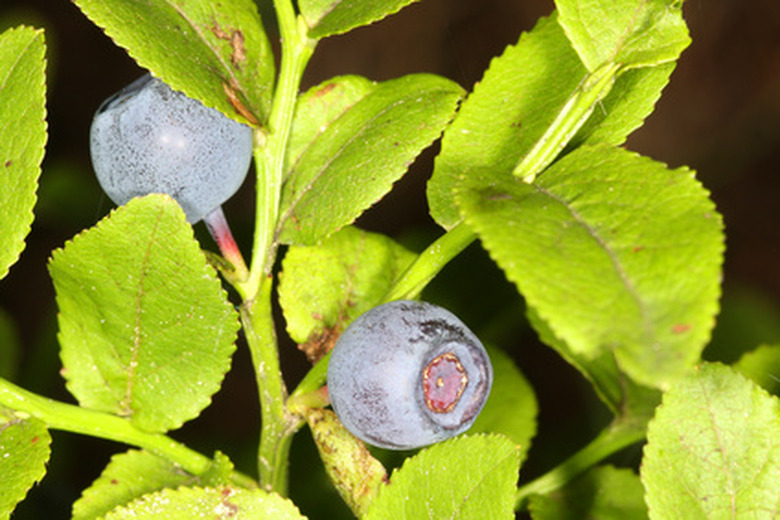Yellow Leaves On Blueberry Bushes
You can plant and grow blueberry bushes in your garden, in a pot or as part of your landscaping. Not only will you be able to harvest fresh, tasty berries, but blueberry bushes are also attractive ornamental bushes. Blueberry bushes do, however, have specific requirements, both nutritional and environmental, for them to successfully grow and thrive.
Significance
Yellow leaves on your blueberry bush during the growing season signifies that something is wrong, either nutritionally or because of disease. The leaves of a plant are generally the first indication that there is a problem. Depending on the ailment, the yellowing will start in between the darker green veins of the leaf, or the leaf may develop yellow on the edge. Monitoring the foliage of your blueberry bush frequently for leaf color change will help you correct a serious problem before any significant damage is done to the plant.
- You can plant and grow blueberry bushes in your garden, in a pot or as part of your landscaping.
- Yellow leaves on your blueberry bush during the growing season signifies that something is wrong, either nutritionally or because of disease.
Identification
When blueberry leaves, either tender new growth leaves or older interior leaves, begin to appear a lighter green or yellow green, it is a good indication your bush is suffering. The leaves will continue to lose the green color and turn yellow, most notably between the veins of a leaf, until the nutrition or environmental situation is corrected. There is one virus, the blueberry stunt, that will cause the leaves of a blueberry to yellow around the edge and between the veins, giving the leaf a mottled look.
Cause
The nutritional or environmental cause of lightening and yellowing of blueberry leaves is called chlorosis, which is the lack of chlorophyll in the plant. There are several factors that can cause chlorosis—compact or damaged roots, poor drainage or a high pH level in the soil which blocks the plant's ability to take up the needed nutrients. The blueberry stunt virus is spread from plant to plant by the leafhopper pest.
Effects
The effect of chlorosis on blueberry shrubs if not detected and corrected soon enough is the bush will have premature leaf drop, and in extreme stress, may ultimately die. Certain nutritional deficiencies, like nitrogen and magnesium, will affect the older, interior leaves of the bush first, while a lack of iron will turn new grow yellow before affecting older leaves. Because the blueberry stunt virus easily spreads to neighboring plants, should one of your blueberry bushes be infected and not treated quickly, the virus will move and infect surrounding plants. Depending on the severity of infection, you may need to completely remove the infected blueberry bush from your garden.
- When blueberry leaves, either tender new growth leaves or older interior leaves, begin to appear a lighter green or yellow green, it is a good indication your bush is suffering.
- The leaves will continue to lose the green color and turn yellow, most notably between the veins of a leaf, until the nutrition or environmental situation is corrected.
Prevention/Solution
To correct the situation and stop the leaves of your blueberry bush from turning yellow, determine the exact cause. This is done primarily through a process of elimination. Start by checking how well the soil is draining. Overly wet soil conditions can block the blueberry roots from being able to absorb the needed nutrients. The same is true if the soil is compacted, which will cause the roots to also be compacted and may be damaged. These conditions can be remedied by supplementing the soil around your blueberry bush with organic material. The organic material will open up the soil, allowing more air into it, which improves drainage and allows the roots to grow and expand more freely. Determining if mineral or nutrients need to be added, or if the pH level should be changed can best be determined with the assistance from your local agricultural extension office. Contact the local office to have your soil tested and recommendations as to what and the amounts of nutrients to add. To alleviate the blueberry stunt virus you must first eliminate the leafhoppers so no more plants are infected. Spray insecticide formulated to eliminate the pest on the infected blueberry bush and surrounding vegetation, then remove and destroy the infected blueberry plants.
- To correct the situation and stop the leaves of your blueberry bush from turning yellow, determine the exact cause.
